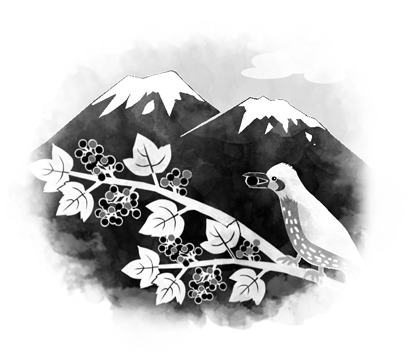





The long rainy season around this time of year is called kinome-nagashi. Once the warm rain moistens the evergreen forests surrounding the village, the light and dark greens begin to lighten—sprouting new greenery every day. Cherry blossoms and azaleas bloom to herald the arrival of spring. Before the mountain climbing and water sport season, a Shinto ritual of “opening of the forests and beach-going season” will be held to pray for safety.


April is a time where young leaves have fully sprouted and all living things are full of life. Colorful, vibrant flowers bloom everywhere throughout the mountains and villages. In the Yakushima Umimatsuri (Yakushima Sea Festival), in which people clean the harbors and shores before the sea turtles start laying eggs, visitors can enjoy canoeing, scuba diving, snorkeling and banana boating.


The mountains grow greener as the sunshine becomes more intense. But the most striking sight is the carpet of Rhododendron on the mountain slopes. Yakushima Shakunage Tozan (Yakushima Rhododendron Trekking) is an event perfect for everyone, even for those who have never trekked before or who want to enjoy doing so alone.
At night, watching the fireflies fluttering from one place to another under a sky full of stars is also a real pleasure of this season.



Every year from May through July, sea turtles come to Inaka-hama to the east and Mae-hama to the west of Nagata River. Only a few Green Turtles can be seen per season, but Yakushima is the number one location for Loggerhead Turtles that come to Japan to lay their eggs. Sea turtles lay 100 to 140 eggs at a time and baby turtles hatch after 60 days and make their way to the sea. Then they come back here to lay eggs once they are grown. Why not take a close look at the mystery of life that has continued for generations?


The end of the rainy season tells us the hot summer has arrived. Following the Shinto ritual to pray for safety on the beach, a long-distance swimming event called Open Water Swimming is held. When you go for a stroll in the evening, look up at a sky full of stars. The air in Yakushima is so clear that you can easily find the silvery sparkling Milky Way.
The harvesting of early harvest rice begins before the typhoon season comes.


The sun shines down on the island and this is the most popular season for tourists and trekkers alike. Festivals are always going on somewhere in Yakushima during summer. Goshinzan Matsuri to thank the god of mountains, and the summer festivals that are held in villages, such as Anbo, feature vendors, stage events and fireworks.



On August 15th of the old calendar, Jugoya Tsunahiki (a tug-of-war under the harvest moon) is held to pray for plentiful fish and good harvests and the well-being of family. Men repeatedly sing Jugoya and tug-of-war songs while slowly pulling the rope until one side wins. They say the rope signifies a strong dragon or a god of water.
The shrill cry sounds of cicada can be heard during the day, but once the silver grass begins to appear you can hear the mass chorus of singing insects in autumn at night.


Although you can feel autumn in the air, the highest temperature in October in an average year is warm at 25 ˚C, and you can still enjoy activities in the sea and on the river, especially river kayaking. It is perfect for beginners and you can enjoy crystal clear, beautiful water in Yakushima.


The air in the morning and evening feels crisp and comfortable. Autumn is a perfect season to go hiking in the hills, where you can hear migratory birds, such as Bulbul. Around the middle of the November, the first snow settles on the peaks of the mountains—which are close to 2,000 m in elevation.
A local specialty, anno-imo (sweet potato), begins to appear on the menu at sankara hotel.



Winter has finally come to the island. A number of winter birds, such as white-eyes and Bulbul, can be seen. Farmers get busy as the harvesting of ponkan orange, a local specialty, begins and preparation for the New Year’s holiday celebration makes progress.
On December 31st, a grand performance of yakujin taiko is dedicated to the gods together with fire at Yaku Shrine where people give thanks for the year that has passed and offer prayers for the coming year.


As the New Year begins, experience traditional nature-inspired events that are unique to Yakushima, such as Onibitaki held on January 7th, as well as Toka Ebisu and Nijusan-ya Matsuri in which people pray to the sun and moon for the safety of the village. The climates of the Japanese islands—from that of Hokkaido to the subtropical—can be experienced during winter in Yakushima. The tops of the high mountains are adorned with snow, yet beautiful poinsettia and bougainvillea are blooming along the shoreline.


As the cold weather begins to warm up, harvesting of tankan and lemons begins and one starts to feel spring in the air.
The snow still adorns the tops of the mountains and one cannot go into them without wearing full winter clothes. However, many unique events are held in the village, such as a cycling tournament in which one rides a bike around the world heritage site of Yakushima, and a trail run in which one runs through subtropical forests of Indian laurel and beaches where sea turtles lay eggs.














